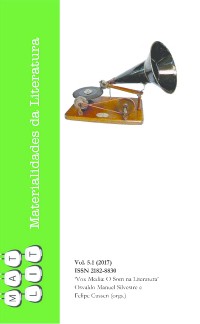Please use this identifier to cite or link to this item:
https://hdl.handle.net/10316.2/93335| DC Field | Value | Language |
|---|---|---|
| dc.contributor.author | Daly, James | - |
| dc.date.accessioned | 2018-03-06T17:59:10Z | |
| dc.date.accessioned | 2020-10-04T00:49:22Z | - |
| dc.date.available | 2018-03-06T17:59:10Z | |
| dc.date.available | 2020-10-04T00:49:22Z | - |
| dc.date.issued | 2017 | - |
| dc.identifier.issn | 2182-8830 | - |
| dc.identifier.uri | https://hdl.handle.net/10316.2/43616 | - |
| dc.description.abstract | A presença de escrita rúnica antes do influxo de alfabetização latina na Inglaterra anglo-saxónica é muitas vezes negligenciada quando se investiga a natureza transicio-nal da oralidade e da literacia na escrita anglo-saxónica vernácula. A presença de runas na sociedade anglo-saxónica e os manuscritos em Old English apoiam a teoria de que a poesia inglesa antiga operou dentro de um período de transição entre oralidade e alfabetização (como argumentaram O’Keeffe (1990), Pasternack (1995), Amodio (2005)). No entanto, os símbolos rúnicos problematizam a definição de oralidade no âmbito dos estudos da oralidade formulaica em Old English, porque as práticas de escrita rúnica são anteriores à alfabetização latina na Inglaterra. Este artigo explora a possibilidade de que a oralidade contida na poesia em Old English seja uma forma de oralidade secundária devido à pré-existência de escrita rúnica na Inglaterra anglo-saxónica. Esta forma de oralidade secundária ocorre dentro da mudança cultural e social mais ampla entre a oralidade primária e os estados modernos hiper-alfabetizados, pois as runas atuam como uma representação literária da mudança na construção do pensamento e da literatura em língua inglesa. Este artigo sugere que as runas podem ser entendidas como um tipo de “literacia transicional” entre a oralidade primária e as práticas literárias alatinadas. Elas funcionam como forma de compor e registar o pensamento enquanto texto ao mesmo tempo que mantêm elementos fortemente associados à construção de uma cultura oral primária no modo como os textos são interpretados por uma cultura familiarizada com a escrita. Por conseguinte, torna-se necessário clarificar o entendimento do Old English como forma poética de transição, a saber, que a natureza e o grau de transição contidos na poesia em Old English se desenvolve a partir de inscrições rúnicas que representam uma transição entre as formas germânica e latina de textualidade e de literacia. | por |
| dc.description.abstract | The presence of runic writing before the influx of Latinate literacy in Anglo-Saxon England is often neglected when investigating the transitional nature of orality and literacy in vernacular Anglo-Saxon writing. The presence of runes in Anglo-Saxon society and Old English manuscripts supports the theory that Old English poetry operated within a transitional period between orality and literacy (as argued by O’Keeffe (1990), Pasternack (1995), Amodio (2005)). However runic symbols prob-lematize the definition of orality within Old English oral-formulaic studies because runic writing practices predate Latinate literacy in England. This article explores the possibility that the orality contained within Old English poetry is a form of secondary orality due to the pre-existence of runic writing in Anglo-Saxon England. This form of secondary orality occurs within the wider social cultural shift between primary orality and modern hyper-literate states as runes act as a literary representation of change within the construction of thought and literature in the English language. This article suggests that runes can be understood as a type of ‘transitional literacy’ be-tween primary orality and Latinate derived literary practices. They act as a way of composing and recording thought as text while still maintaining elements strongly associated with the construction of a primary oral culture in how the texts are inter-preted by a culture familiar with writing. Therefore clarification must be made when understanding Old English as a transitional poetic form, namely that the nature and degree of transition contained within Old English poetry builds upon runic inscrip-tions as it represents a transition between a Germanic and Latinate forms of textuali-ty and literacy. | eng |
| dc.language.iso | eng | - |
| dc.publisher | Centro de Literatura Portuguesa | - |
| dc.publisher | Imprensa da Universidade de Coimbra | - |
| dc.rights | open access | - |
| dc.subject | runic writing | eng |
| dc.subject | Old English poetry | eng |
| dc.subject | secondary orality | eng |
| dc.subject | transi-tional literacy | eng |
| dc.subject | textuality | eng |
| dc.subject | escrita rúnica | por |
| dc.subject | poesia em Old English | por |
| dc.subject | oralidade secundária | por |
| dc.subject | literacia transicional | por |
| dc.subject | textualidade | por |
| dc.title | Orality, Germanic Literacy and Runic Inscriptions in Anglo-Saxon England | por |
| dc.type | article | - |
| uc.publication.collection | Matlit v. 5, nº 1 | - |
| uc.publication.firstPage | 39 | - |
| uc.publication.issue | 1 | - |
| uc.publication.lastPage | 52 | - |
| uc.publication.location | Coimbra | - |
| uc.publication.journalTitle | MATLIT: Materialidades da Literatura | - |
| uc.publication.volume | 5 | por |
| dc.identifier.doi | 10.14195/2182-8830_5-1_3 | - |
| uc.publication.orderno | 3 | - |
| uc.publication.area | Artes e Humanidades | - |
| uc.publication.manifest | https://dl.uc.pt/json/iiif/10316.2/93335/263476/manifest?manifest=/json/iiif/10316.2/93335/263476/manifest | - |
| uc.publication.thumbnail | https://dl.uc.pt/retrieve/12071891 | - |
| item.grantfulltext | open | - |
| item.fulltext | With Fulltext | - |
| Appears in Collections: | Matlit | |
Files in This Item:
| File | Description | Size | Format | |
|---|---|---|---|---|
| orality__germanic_literacy.pdf | 915.87 kB | Adobe PDF |  |
Items in DSpace are protected by copyright, with all rights reserved, unless otherwise indicated.
